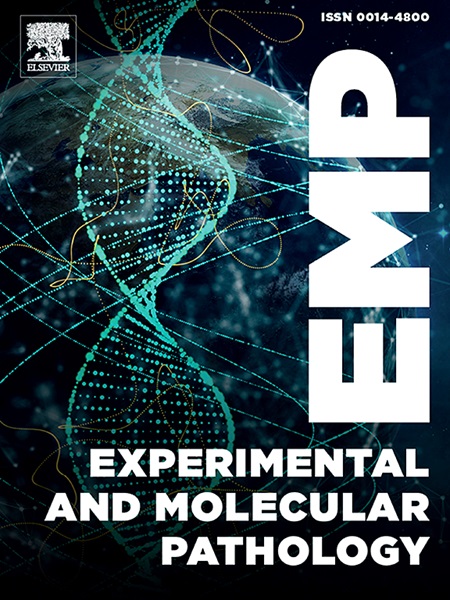类风湿关节炎患者IL-6受体/STAT3下游信号的调节
IF 3.7
4区 医学
Q2 PATHOLOGY
引用次数: 0
摘要
白细胞介素-6 (IL-6)是类风湿关节炎(RA)发病过程中的一种相关细胞因子,可能激活Janus激酶(JAK)-1、-2和酪氨酸激酶2 (TYK2),因此是三种信号转导和转录激活因子(STAT)-1、-3或- 5途径。本初步研究旨在探讨RA患者、非RA患者(nRA)和健康供者(HD)之间磷酸化(p)STAT3水平的差异,为每种JAK蛋白在il -6诱导的STAT3通路下游的相对贡献提供一些线索。收集了80例受试者(41例RA, 14例nRA, 25例HD)的临床资料和血液样本。Western Blot和Real - Time-PCR检测JAK-STAT3通路的活性,定量外周血单核细胞(PBMC)中STAT3的表达。此外,通过体外FACS评估JAK-1, -2和TYK2抑制剂对pSTAT3的影响,在RA患者中,有和没有IL-6刺激naïve对DMARD和类固醇治疗。与非RA患者和HD患者相比,RA患者PBMC中的pSTAT3(%)显著升高。此外,pSTAT3(%)与炎症和疾病活动性(ESR、CRP和DAS28)显著相关。JAK-1抑制剂在RA患者CD14pos细胞中降低pSTAT3表达更有效,而JAK-2选择性化合物在RA患者CD4pos细胞中更有效。与之相反,TYK2选择剂没有表现出明显的作用。本研究强调了JAK/STAT3通路在RA中的重要性。各种JAK蛋白之间存在一些差异,在IL-6R激活后的体外模型中,JAK1和JAK2是STAT3通路最相关的介质。本文章由计算机程序翻译,如有差异,请以英文原文为准。
Modulation of IL-6 receptor/STAT3 downstream signaling in rheumatoid arthritis patients
Interleukin-6 (IL-6) is a relevant cytokine in rheumatoid arthritis (RA) pathogenesis, potentially activating Janus kinases (JAK)-1, −2, and tyrosine kinase 2 (TYK2), and thus, three signal transducer and activator of transcription (STAT)-1, −3 or − 5 pathways. This pilot study aims to explore differences in phosphorylated (p)STAT3 levels among patients with RA, those not classified as RA (nRA), and healthy donors (HD), providing some clues on the relative contribution of each JAK protein to the downstream of the IL-6-induced STAT3 pathway. Clinical data and blood samples from 80 subjects (41 RA, 14 nRA, and 25 HD) were collected. The activity of the JAK-STAT3 pathway was assessed by Western Blot and Real Time-PCR analysis for the quantification of STAT3 in peripheral blood mononuclear cells (PBMC). Furthermore, the impact of JAK-1, −2, and TYK2 inhibitors on pSTAT3 was assessed in vitro by FACS, with and without IL-6 stimulation in RA patients naïve to treatment with DMARD and steroids. The pSTAT3 (%) was significantly higher in PBMC from RA compared to nRA patients and HD. Furthermore, pSTAT3 (%) was significantly associated with inflammation and disease activity (ESR, CRP, and DAS28). The JAK-1 inhibitor was more effective in reducing pSTAT3 expression in CD14pos cells of RA patients, while the JAK-2 selective compound was more effective in CD4pos cells of RA patients. On the contrary, the TYK2 selective agent showed no significant effects. This study highlights the importance of the JAK/STAT3 pathway in RA. Some differences among various JAK proteins have been pointed out, with JAK1 and JAK2 standing as the most relevant mediators of the STAT3 pathway in this in-vitro model after IL-6R activation.
求助全文
通过发布文献求助,成功后即可免费获取论文全文。
去求助
来源期刊
CiteScore
8.90
自引率
0.00%
发文量
78
审稿时长
11.5 weeks
期刊介绍:
Under new editorial leadership, Experimental and Molecular Pathology presents original articles on disease processes in relation to structural and biochemical alterations in mammalian tissues and fluids and on the application of newer techniques of molecular biology to problems of pathology in humans and other animals. The journal also publishes selected interpretive synthesis reviews by bench level investigators working at the "cutting edge" of contemporary research in pathology. In addition, special thematic issues present original research reports that unravel some of Nature''s most jealously guarded secrets on the pathologic basis of disease.
Research Areas include: Stem cells; Neoangiogenesis; Molecular diagnostics; Polymerase chain reaction; In situ hybridization; DNA sequencing; Cell receptors; Carcinogenesis; Pathobiology of neoplasia; Complex infectious diseases; Transplantation; Cytokines; Flow cytomeric analysis; Inflammation; Cellular injury; Immunology and hypersensitivity; Athersclerosis.

 求助内容:
求助内容: 应助结果提醒方式:
应助结果提醒方式:


